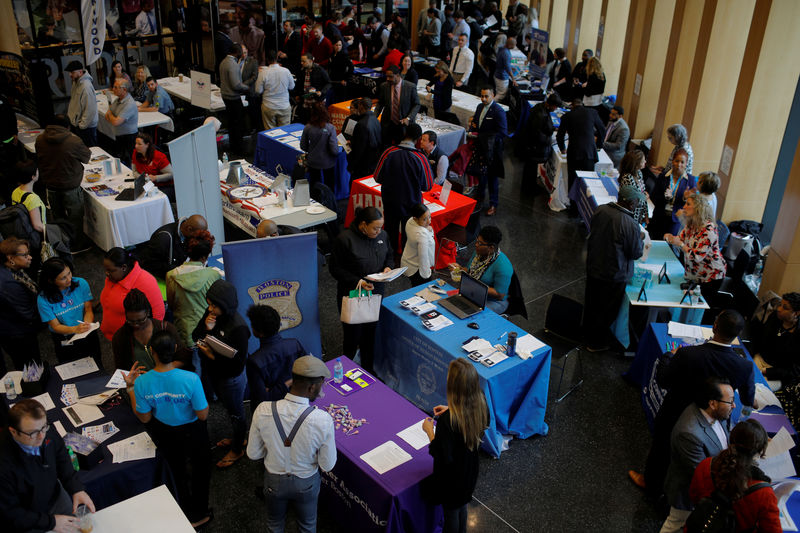By Lucia Mutikani
WASHINGTON (Reuters) - U.S. job growth almost stalled in February, with the economy creating only 20,000 jobs as construction and retail payrolls dropped, which could raise concerns about a sharp slowdown in economic activity.
The job growth reported by the Labor Department on Friday was the weakest since September 2017, but it probably understated the health of the labor market as other details of the closely watched employment report were strong.
The unemployment rate fell back to below 4 percent and annual wage growth was the best since 2009. In addition, data for December and January were revised to show 12,000 more jobs created than previously reported.
Still, the economy that in July will mark 10 years of expansion, the longest on record, is slowing and the weakening job gains support the Federal Reserve's "patient" approach toward further interest rate increases this year.
"The sharp slowdown in payroll employment growth in February provides further evidence that economic growth has slowed in the first quarter," said Michael Pearce, senior U.S. economist at Capital Economics in New York. "That adds weight to our view that the Fed will not be raising interest rates this year."
Economists polled by Reuters had forecast non farm payrolls rising by 180,000 jobs last month and the unemployment rate falling to 3.9 percent.
The slowdown likely reflected the fading weather-related boost in the prior two months and workers becoming more scarce. A stock market selloff and jump in U.S. Treasury yields in late 2018, which tightened financial market conditions, were also likely factors.
About 390,000 workers stayed at home in February because of the bad weather, not much different from previous years. The length of the average workweek fell to 34.4 hours from 34.5 hours in January.
U.S. stock index futures extended losses and yields on U.S. Treasuries plummeted after the release of the data. The dollar held earlier losses.
SLOWING ECONOMY
The moderation in hiring was flagged by first-time applications for jobless benefits, which were elevated in February. Also, Institute for Supply Management surveys showed measures of manufacturing and services sectors employment dropped in the month, while the Fed on Wednesday reported "modest-to-moderate gains" in employment in a majority of the U.S. central bank's districts.
Though the economy grew 2.9 percent in 2018, its strongest performance in three years, it lost momentum as the year ended. Retail sales, homebuilding, business spending and exports all declined in December, setting the economy on a slower growth path.
Despite the weakness in hiring last month, the unemployment rate fell two-tenths of a percentage point to 3.8 percent in February as federal government workers who were temporarily unemployed during a 35-day partial shutdown returned to work. The longest shutdown in U.S. history ended on Jan. 25.
A broader measure of unemployment, which includes people who want to work but have given up searching and those working part-time because they cannot find full-time employment, dropped to 7.3 percent after hitting an 11-month high of 8.1 percent in January because of the government shutdown.
Average hourly earnings rose 11 cents, or 0.4 percent, in February, partly because of a calendar quirk, after gaining 0.1 percent in January. That raised the annual increase in wages to 3.4 percent, the biggest gain since April 2009, from 3.1 percent in January. Overall, wage inflation remains moderate.
A report on Thursday showed labor costs rising only 1.4 percent in 2018, the smallest gain since 2016, after increasing 2.2 percent in 2017.
Economists say employers have kept hiring at a strong pace despite low unemployment as more people returned to the labor force, including students, women and people who had dropped out to collect disability benefits. They, however, say that source of labor supply is dwindling.
The labor force participation rate, or the proportion of working-age Americans who have a job or are looking for one, was unchanged last month at more than a five-year high of 63.2 percent.
Last month, employment at construction sites fell by 31,000 jobs, the biggest drop since December 2013, after increasing by 53,000 in January. The leisure and hospitality sector added no jobs last month after payrolls increased by 89,000 in January.
The manufacturing sector added 4,000 jobs in February after hiring 21,000 workers in the prior month. Retail payrolls fell by 6,100 jobs. There were also job losses in the utilities as well as transportation and warehousing industries. Government payrolls declined by 5,000 jobs last month.
Professional and business services employment increased by 42,000 jobs in February. The education and health care sector added only 4,000 jobs.
